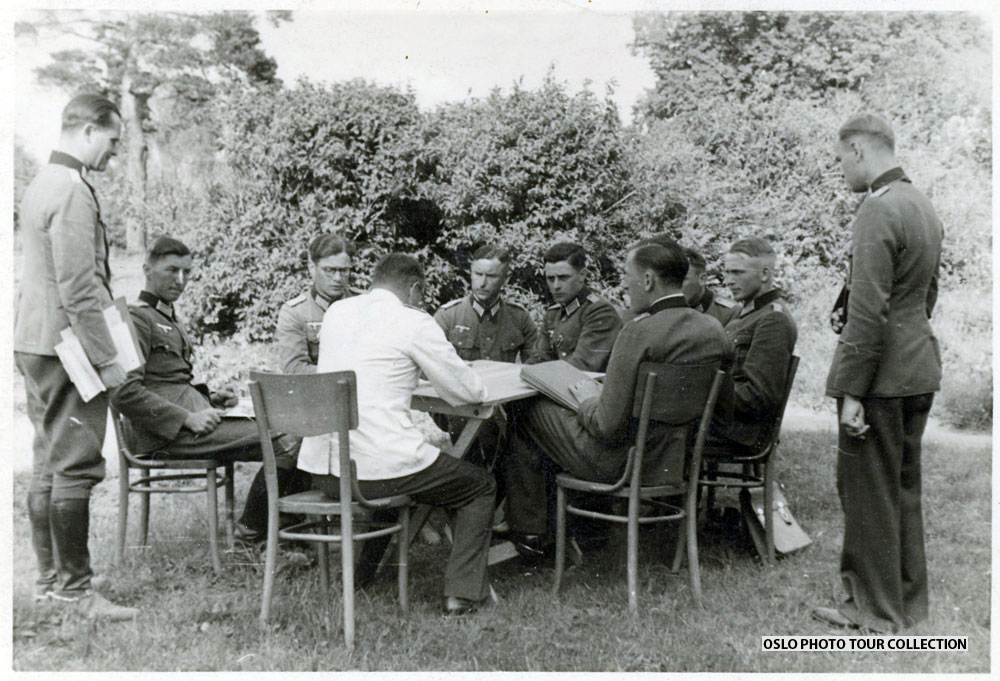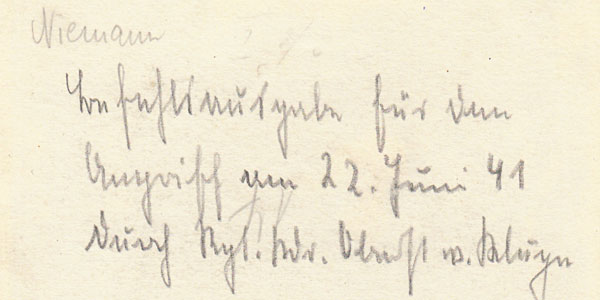

командный пункт для атаки 22.06.41. Regimentskommandeur Оберст фон Клюге
Скорее всего, это “Гюнтер Адольф Фердинанд фон Клюге (30 октября 1882 – 19 августа 1944), также известный как Ганс Гюнтер фон Клюге, был немецким фельдмаршалом во время Второй мировой войны, который командовал как на Восточном, так и на Западном фронтах. Клюге командовал 4-й армией во время операции “Барбаросса” (вторжение в Советский Союз) и битвы за Москву в 1941 году.
Хотя Клюге не был активным участником заговора 20 июля, после неудавшегося переворота он покончил жизнь самоубийством 19 августа 1944 года, после того как был отозван в Берлин для встречи с Гитлером”. информация из Википедии
фотограф: Сержант-майор армии Franz Richarz.
С января по август 1937 года во 2-й роте инженерного батальона 26 в Кёльн-Вестховене. С сентября 1937 года в составе 1-й роты 2-го инженерного батальона (Pionier-Lehr-Bataillon 2) в Фюрстенвальде. Вторжение в Австрию в марте 1938 года, в октябре 1938 года в Судетскую область, Демобилизован в качестве сержанта в Фюрстенвальде в конце октября 1938 года. Мобилизация в августе 1939 года в составе 6-й роты 68-го железнодорожного инженерного полка, С этим подразделением он затем был направлен в Польшу и на Западный вал.
В апреле 1940 года его подразделение было переименовано в 6-й железнодорожный инженерный полк 3. Затем он воевал в Бельгии, Франции и на южном участке Восточного фронта до 1944 года. Ранен в Крыму (16.02.1944), пережил войну.
command output for the attack on 22.06.41. Regimentskommandeur Oberst von Kluge.
additional information from Wiki:
Most probably it is “Günther Adolf Ferdinand von Kluge (30 October 1882 – 19 August 1944), also known as Hans Günther von Kluge, was a German field marshal during World War II who held commands on both the Eastern and Western Fronts. Kluge went on to command the 4th Army in Operation Barbarossa (the invasion of the Soviet Union) and the Battle for Moscow in 1941.
Although Kluge was not an active conspirator in the 20 July plot, in the aftermath of the failed coup he committed suicide on 19 August 1944, after having been recalled to Berlin for a meeting with Hitler.”
photographer: Sergeant Major of the Army Franz Richarz.
January to August 1937 with the 2nd Company of the Engineer Battalion 26 in Cologne-Westhoven. From September 1937 with the 1st Company of the Engineer-Lehr-Bataillon 2 in Fürstenwalde. March 1938 invasion of Austria, October 1938 in the Sudetenland, End of October 1938 discharged as NCO in Fürstenwalde. August 1939 mobilization with d. 6. company of the Eisenbahn-Pionier-Regiment 68, with this unit he was then deployed in Poland and at the Westwall. April 1940 renamed his unit to 6th / Railway Engineer Regiment 3. He then fought in Belgium, France and on the southern section of the Eastern Front until 1944. Wounded in the gang fight in the Crimea (16.02.1944), he survived the war.
original text: Oberfeldwebel des Heeres Franz Richarz.
Januar bis August 1937 bei d. 2. Kompanie des Pionier-Bataillon 26 in Köln-Westhoven. Ab September 1937 bei d. 1. Kompanie des Pionier-Lehr-Bataillon 2 in Fürstenwalde. März 1938 Einmarsch in Österreich, Oktober 1938 im Sudetenland, Ende Oktober 1938 als Unteroffizier in Fürstenwalde entlassen. August 1939 Mobilmachung bei d. 6. Kompanie des Eisenbahn-Pionier-Regiment 68, mit dieser Einheit wurde er dann in Polen und am Westwall eingesetzt. April 1940 Umbenannung seiner Einheit in 6./ Eisenbahn-Pionier-Regiment 3. Er kämpfte dann in Belgien, Frankreich und am Südabschnitt der Ostfront bis 1944. Verwundet im Bandenkampf auf d. Krim (16.02.1944), hat er den Krieg überlebt.